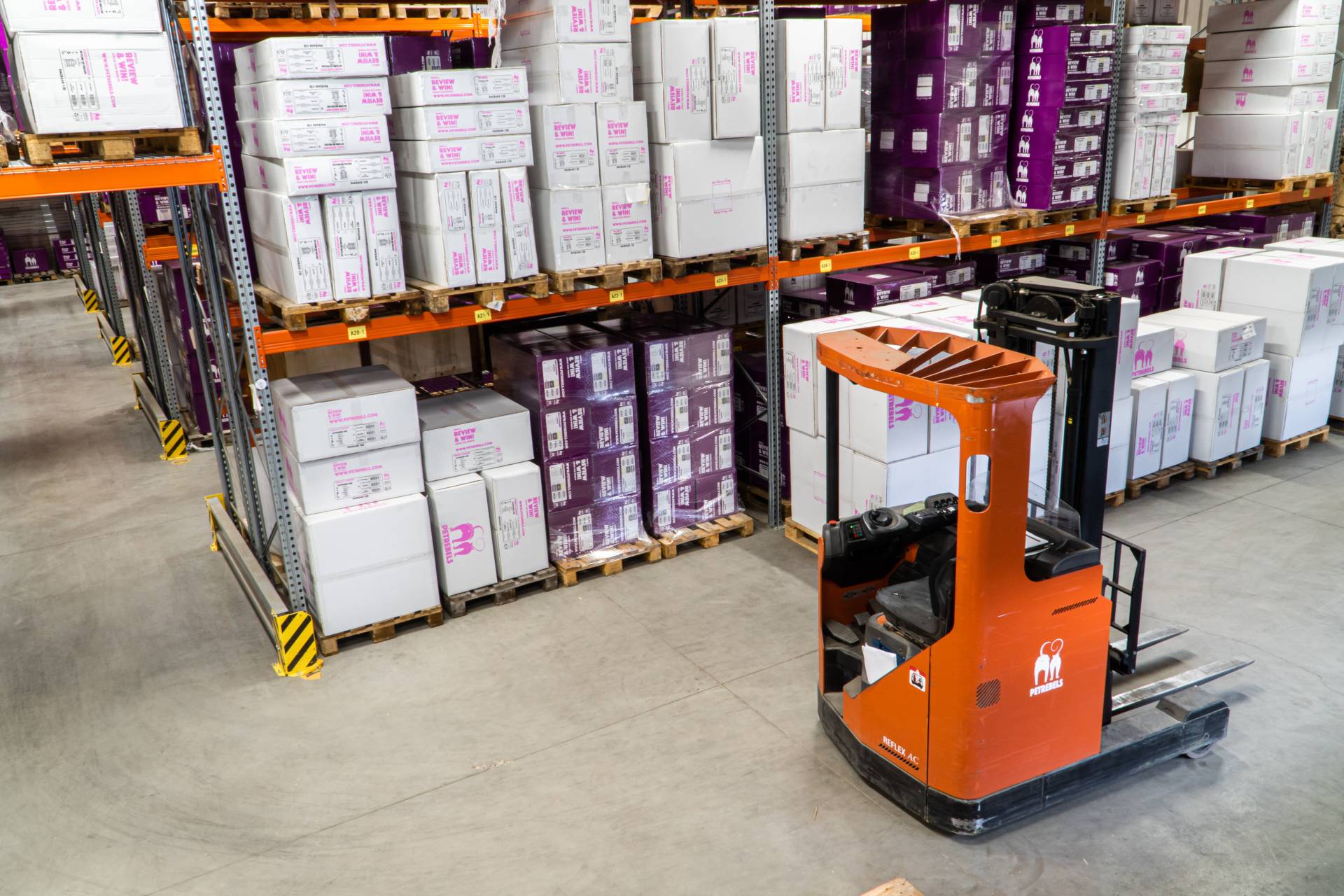As we look into the crystal ball of warehouse inventory management, one thing is clear: the future lies in warehouse automation. Statistic says there will be around 50,000 robotic warehouses by 2025, with over four million robots. According to Gartner, machine automation will probably double in the next five years.
The reason is simple.
Warehouse automation can increase efficiency by replacing repetitive, labor-intensive warehouse tasks.
The pandemic played havoc with inventory planning. Many supply chain managers are still struggling with warehouse operations.
To face supply chain disruptions, SCMs need a robust inventory management system and efficient processes. Here are some recommendations and strategies to use.
How warehouse automation can improve inventory management
Poor inventory management can have devastating effects on manufacturing businesses. Inefficient inventory management affects the following activities:
- storing
- transport
- delivery logistics
- customer satisfaction.
That was painfully obvious during the pandemic.
Clothing brands under-inventoried in mid-2020 for the holidays as they weren’t sure of the demand. For Levi’s, the strategy worked as they were ready to miss some sales rather than overstock. They did not need to go into huge discount sales, which reflected in their profits.
But some other brands adopted the same strategy. They suffered abandoned carts online and offline because of insufficient stock. This was why Walmart and Target had to mark down huge stocks: they needed to make way for a fresh stock for school reopenings in July. Their profit margins for the upcoming quarters suffered.
Insufficient stock means lost sales. If you under-order, you’re not using warehouse capacity optimally. This can easily leave you unable to meet customer demand. Over-ordering leads to loss and waste and having to pay for storing the extra goods. Reducing stock-outs and overstocks can lower inventory costs by 10%.
Automating inventory and warehouse automation reduces human errors. It is also a predictive solution where it analyzes your key performance indicators. You get an insight into the planning that can amplify your throughput.
Here are nine vital ways how warehouse automation can improve inventory management.
1. Warehouse inventory classification helps increase efficiency
Inventory classification according to turnover and profitability will increase efficiency. Companies usually use the ABC analysis method to categorize the products in their warehouses.
A-level products are those that have the highest demand and value. C-level products are slow-moving products that do not need to be replaced regularly. The B-category falls somewhere in the middle.
You should take care of purchase orders, warehouse placements, and stock-taking for these products regularly.
Image Credit: Provided by the Author; Unsplash; Thank you!
Warehouse management systems (WMS) facilitate redistributing goods according to the ABC categorization. A WMS also helps to move the fast turnover and in-demand goods closer to the exit to streamline their dispatch. Similar is the case with stock replenishment and stock movement.
Automation also helps in easy re-categorization when items move from one category to the other by re-zoning the layout, etc.
2. AI can help the stock based on actual and predicted demand
AI used in inventory management can take care of stock based on actual and predicted demand. An example is Ocado, a U.K. grocery technology company: they reached near-zero waste levels using the technology.
There was also one Gartner study, cited by VentureBeat, according to which supply chain officers (84%) stated that data-driven insights helped them in customer service.
The need to build a buffer against unexpected events has led many companies to have extra stocks.
It’s not the investment tied down in inventory. Also, the cost of storage, insurance on space, and goods and taxes drive costs up. Outsourcing these tasks to third-party logistics or 3PL could be the answer to new challenges.
3. Warehouse automation is the answer to the labor gap
A World Bank Logistics Performance Index survey says a workforce gap exists in:
- administrative supervisory
- operative
- logistics spaces.
According to the Bureau of Labor Statistics, the annual warehouse turnover rates in 2021 are nearly 50%. Post-pandemic, there has been an exodus of workers called the “great resignation”. People are not eager to get back to work. Supply chain leaders recognize that automation is the answer to the labor gap.
Deloitte research says that less than 40% of supply chain leaders were sure of the abilities of their current employees. Predictive analytics, automation, and digitized platforms help cut costs and bring efficiency. But employees need to know how to use the tech.
Staff training in both processes and tools is a big step toward the goals. Stocking and efficient use of warehouse space become optimal with trained staff. Experts recommend building an in-house task force. An in-house team is usually invested in the company’s progress. They’re also more loyal and committed to staying on board.
Image Credit: Provided by the Author; Unsplash; Thank you!
4. IoT devices help efficiently manage inventories
McKinsey analysis predicts that IoT’s value in the industry could surpass $560 billion by 2025. According to the same source, IoT will contribute to:
- supply chain management
- inventory management
- logistics.
Sensors and integrated systems help manage inventories and storage facilities. IoT devices such as beacons, drones, RFIDs, and sensors come in handy. They scan, share, store and help send real-time information to a central system.
IoT has found great use in the transport and retail segments. In fleet management, sensors convey data about:
- the location
- driver fatigue
- optimal speed
- state of goods
- pilferage.
In retail, IoT makes the inventory tracking process much easier. It helps achieve a high operational efficiency in factories and stores. The retail IoT market could reach $42.6 billion by 2029.
5. AGVs and AMRs increase order accuracy to 99.99% or above!
AGVs (AS/RS) have the potential to increase order accuracy levels to above 99.99%. These vehicles ramp up the storage and retrieval process.
These industries are already reaping the benefits of using next-generation automated material-handling equipment:
- aerospace
- agriculture
- automotive
- construction
- manufacturing
- e-commerce
- retail
- pharmaceutical.
Managers in the auto and pharma industries are using these retrieval systems to improve process flows. The systems also increase safety levels and help in better shelving.
- The AS/AR systems must integrate with the other tech solutions for efficient output. They can also connect to a company’s network. This makes monitoring their load handling easier.
- Automated guided vehicles feature sensors and detectors and can move on preset pathways.
- Robots are useful on an assembly line and for doing repetitive tasks.
6. Cobots help reduce errors and prevent accidents
Collaborative robots — or “cobots” — work alongside humans. They help reduce errors and prevent accidents caused by repetitive tasks. That way, they improve the efficiency of the assembly process.
A news report says that there were roughly 60,000 orders for warehouse-ready robots in 2020. In 2021, these orders jumped to 100,000. Amazon and Walmart already have robots operating in their fulfillment centers and warehouses. They are possible answers to the present labor crunch.
Amazon has recently come up with a new robotics arm called Sparrow. It also announced a $1 billion investment in automation and robotics.
One more big player started using advanced technology. Walmart deployed robotic solutions and software automation platforms. Their partner for this upgrade was Symbiotic.
7. Big Data and Blockchain help companies with quicker decision-making
The technology helps companies with quicker decision-making.
The data generated through A.I. allows for tracking and stock-taking without manual interference. It increases productivity by freeing workers from doing these tasks.
Image Credit: Provided by the Author; Unsplash; Thank you!
With A.I. identifying supply anomalies, inventory management becomes automated and optimal. Blockchains that are transparent and tamper-proof — they allow tracking of the movement of goods right from the source to the consumer. That way, every stakeholder has a transparent overview of the transactions. Blockchains also provide an immutable record — including timestamps — that doesn’t allow counterfeit goods or services.
Bext360, a SaaS company, uses blockchain and AI to digitize the supply chain of global commodities. The company tracks the origin and payments through blockchain tech in the coffee industry. It certainly leads to improved productivity.
In conclusion, blockchains are lean and efficient. They integrate disparate transactions into one decentralized ledger. It is also accurate and quicker, thus saving operational costs.
8. Warehouse drones provide more data accuracy and work efficiency
Drones in inventory management or product delivery tasks can boost work efficiency. Companies also used drone deliveries for curbside pickups during the pandemic.
Henceforth, Walmart started using drones to deliver wellness and grocery products during the pandemic. Amazon launched its own Prime Air Drone delivery service. It has autonomous robots named Scouts on delivery test runs.
A study by McKinsey said that the rate of automation in global deliveries would reach nearly 80% in the next decade.
9. Mobile warehousing is highly useful in last-mile delivery
Mobile warehousing is an innovative strategy to overcome rental costs. They also enable quicker deliveries and more efficient storage. It is highly useful in last-mile delivery and can be a viable option in urban centers.
Companies can use mobile warehousing as a receiving and returns facility with shorter delivery runs. They can also hire mobile vans or trailers during high-demand seasons. The mobility factor makes this option competitive in both price and timescale.
Changing needs of supply chain management
The recent disruptions in the supply chain dynamics have made certain things clear. Third-party logistics companies will find greater acceptance. The supply chain as an industry will find more investors and innovations. To avoid supply chain bottlenecks, companies will want to be better prepared. And near-shoring is an attractive option.
3PL: A greater use of such companies — for better implementation, logistics, and cost efficiencies — is the future. It’s important to realize that the 3PL (or third-party logistics) industry is keeping the global supply chains moving. It is a significant factor behind the success of the e-commerce sector worldwide. As a result, according to the 2022 Global Supply Chain Disruptions study, over 40% of respondents have increased their usage of global 3PLs.
Private equity professionals are gravitating towards the supply chain niche. They are gravitating toward tech and software segments within the broader supply chain space. They recognize that groundbreaking technology will optimize complex supply chains in the future.
P.E. companies are financing warehouse innovations to reduce the cost of delivering a positive supply chain experience. P.E. investment in supply chain technology increased from nearly $8 billion in 2020 to $20 billion in 2021. The size of the market is expected to grow to over $60 billion by 2030.
Last-mile fulfillment has become a big challenge in order fulfillment. Customers want products on their doorstep as fast as possible, but fulfillment companies need to think about the cost. That’s why eCommerce businesses and 3PL companies need to adapt to consumer demand and leverage technology to cut costs. Autonomous delivery vehicles and predictive shipping are good examples of new trends.
The warehouse automation market is thriving
The demand for warehouse management systems is rising due to fluctuating consumer requirements. Another key point is the need to keep pace to improve efficiency and optimize productivity. In either case, a good indicator of this change is that the warehouse automation market for 2026 is estimated to surpass 30 billion U.S. dollars.
All things considered, cost and labor efficiency are the key trends triggering market growth. The global warehouse management system’s market size is expected to grow at a compound annual growth rate (CAGR) of 16.1% from 2022 to 2030; its value in 2021 was $2.94 billion.
In 2020, 78% of organizations had already implemented Robotics process automation (RPA), and 16% planned to do so in the ensuing three years. All manufacturers and retailers are witnessing a renewed push after a lull during the pandemic.
None can afford to miss the delivery commitments and deadlines. Continued supply chain bottlenecks are affecting all industries. The answer lies in better inventory management. Developing a Plan B — alternative near-shore sources of supply — is key.
Conclusion
The main factors that will affect the supply chain processes of the future are:
- intelligent automation
- blockchain ledgers
- smart mobility.
The pandemic upheavals have brought into focus resilience and risk management. Supply chain as a Service (ScaaS) will offer operational maintenance within their enterprise solutions.
Companies will look for near-shore supply and source options. The recent resurgence during the Covid-19 wave in China reinforces this point.
The companies that jump on board will be adaptive, resilient, and technically ‘smart’. Warehouse automation will be a must-do instead of a might-do.
As a result, the labor crunch in the industry will see a transition. There are required skill sets to run the tech and do data analytics for better decision-making.
Supply chain processes and management have attracted investor interest in the last five years. Private funding and equity will drive innovations. Also, technology adoption will come along with attracting the right talent.
Featured Image:
The post Warehouse Automation Helps With Efficient Inventory Management appeared first on ReadWrite.





Comentarios recientes